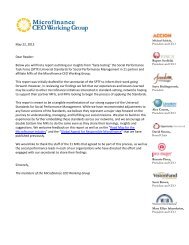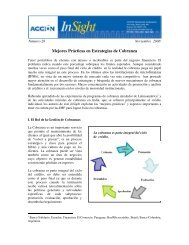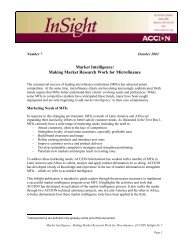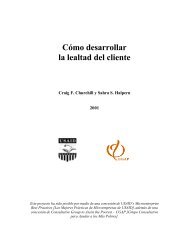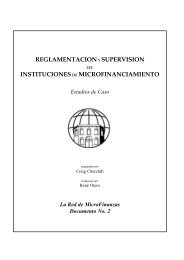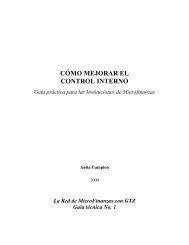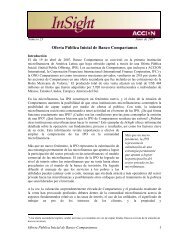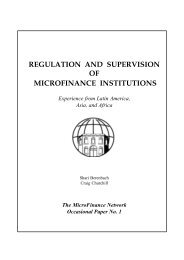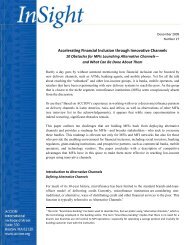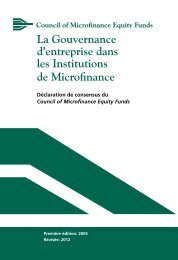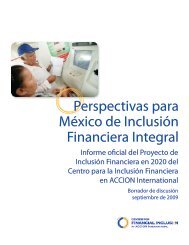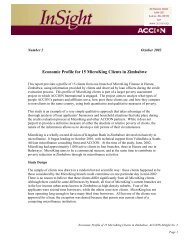Microfinance and Capital Markets - Council of Microfinance Equity ...
Microfinance and Capital Markets - Council of Microfinance Equity ...
Microfinance and Capital Markets - Council of Microfinance Equity ...
Create successful ePaper yourself
Turn your PDF publications into a flip-book with our unique Google optimized e-Paper software.
(approximately at GNP per capita), with some 70% <strong>of</strong> loans below this average. By theend <strong>of</strong> 1996, the loan portfolio was about $1.7 billion. 5Perhaps even more impressive was the growth in savings during this same period. Beforethe transformation <strong>of</strong> the village units from 1973–1983, savings mobilized through thenational savings system totaled $30 million. As <strong>of</strong> end 1996, total unit desa savingsapproached $3.0 billion, or nearly $800,000 per unit desa, in 16.2 million savingsaccounts. Equally impressive is that the average size <strong>of</strong> these deposits in the primarysavings products was US$184. This represented some 30% <strong>of</strong> the total number <strong>of</strong> savingsaccounts in Indonesia, serving 10% <strong>of</strong> Indonesia’s population. 6The BRI unit desa system broke even after just 18 months in operation, in part due to theadvantage <strong>of</strong> inheriting the BIMAS Program unit desa infrastructure. Pr<strong>of</strong>its <strong>of</strong> just $6million in 1986 rose to $177 million by 1996. Return on average equity (ROE), whichwas 63% from 1990–1993, more than doubled to 134% in 1996 7 . Return on assets (ROA)averaged 4.6% over the seven years 1990–1996. The long-term loan-loss ratio <strong>of</strong> theprogram averaged 2.15% over this period <strong>of</strong> time, with the 12-month loan-loss rate at1.59% in 1996. 8These high growth years for the unit desas ran parallel to the growth <strong>of</strong> the overallIndonesian economy, which experienced more than a decade <strong>of</strong> uninterrupted growth. In1970 about 60% <strong>of</strong> Indonesians lived below the poverty line; by 1996 just 11% <strong>of</strong> thepopulation lived below the poverty line. 9 This is a remarkable achievement for anydeveloping economy. The unit desas benefited from this period <strong>of</strong> stable <strong>and</strong> strongeconomic growth. In turn the working poor in rural villages benefited from the extensivevillage network <strong>of</strong> BRI, the opportunity to save safely while earning a decent return <strong>and</strong>the loans <strong>of</strong>fered under KUPEDES.However, 1996 was a watershed year for the Indonesian economy. By 1997, the economywas deeply enmeshed in the East Asian crisis that spread rapidly throughout the regionfrom its origins in Thail<strong>and</strong>. 10 Indonesia’s GDP, which had exp<strong>and</strong>ed by some 8.0% ayear for more than a decade, plunged by 13% in 1998. 11In the aftermath <strong>of</strong> the East Asian crisis, BRI was listed as part <strong>of</strong> a package <strong>of</strong> threebanks who were majority owned by the Indonesian government. The crisis adverselyaffected the banking sector in Indonesia, forcing the government to intervene <strong>and</strong> recapitalizemany <strong>of</strong> the state-owned banks, especially large commercial banks such as BRI(BRI was re-organized in 1997 as a commercial bank prior to the crisis, however the5 Ibid., xiv. See also BRI Unit Products, Bank Rakyat Indonesia <strong>and</strong> USAID, International Visitor Program.6 Ibid., xv.7 It is not clear how much equity was allocated to the unit desa system, therefore its real equity base mightbe understated, <strong>and</strong> these very high returns on equity may be misleading.8 Ibid., xvii-xx. See also BRI Unit Products, Bank Rakyat Indonesia <strong>and</strong> USAID, International VisitorProgram. See also Robinson, <strong>Micr<strong>of</strong>inance</strong> Revolution Volume 2, 388, for the loan loss percentage data.9 Robinson, <strong>Micr<strong>of</strong>inance</strong> Revolution Volume 2: Lessons from Indonesia, 38.10 For an excellent discussion <strong>of</strong> the crisis see Robinson, <strong>Micr<strong>of</strong>inance</strong> Revolution Volume 2, 46-58.11 Ibid., 48.8



